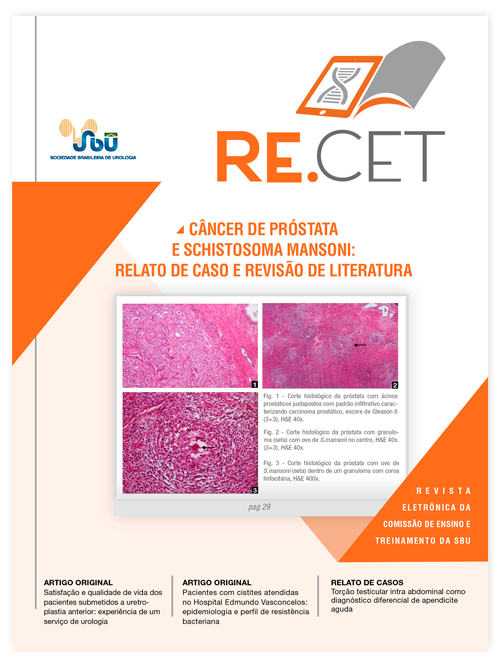Pacientes com Cistites Atendidas no Hospital Edmundo Vasconcelos: Epidemiologia e Perfil de Resistência Bacteriana
Palavras-chave:
Palavras-Chave: Cistite não complicada; uropatógenos; perfil de resistência; epidemiologia.Resumo
Objetivo: Avaliar o perfil epidemiológico e de resistência bacteriana de pacientes com cistite não complicada acompanhadas pelo serviço de Urologia no Hospital Edmundo Vasconcelos - São Paulo.
Métodos: Estudo prospectivo, observacional e descritivo. Os dados foram obtidos através de formulários durante a anamnese e através de análise de prontuários e dos resultados de exames complementares. Os resultados foram analisados de forma anônima e apresentados de forma agregada.
Resultados: Em relação aos resultados da urocultura inicial, a bactéria Escherichia coli foi observada em 44 pacientes (69,84%); a seguir, Klebsiella pneumoniae em 5 (7,94%); S. saprophyticus em 2 (3,17%); P. mirabilis em 2 (3,17%); e P. penneri em 1 (1,59%). Destas, evidenciou-se E. coli multissensível em 31 exames (57,41%); E. coli resistente a quinolonas em 8 (14,81%); E. coli resistente a nitrofurantoína em 3 (5,55%); E. coli resistente a fosfomicina em 2 (3,70%); Klebsiella pneumoniae multissensível em 5 (9,25%); S. saprophyticus multissensível em 2 (3,70%). Em relação ao tratamento empírico realizado, 44% dos pacientes foram tratados com fluoroquinolonas. Em relação às drogas de primeira linha, obtivemos 22% e 25% de tratamento empírico com fosfomicina e nitrofurantoína, respectivamente.
Conclusão: Esses achados assemelham-se ao que a literatura evidencia. E. coli multissensível foi o agente etiológico mais comum, porém E. coli resistente a quinolonas representou proporção significativa (cerca de 18%), com baixas taxas de resistência a nitrofurantoína e fosfomicina. Tais achados reforçam a necessidade de seguir protocolos de antibioticoterapia em cistites não complicadas, visando a diminuição das consequências negativas da antibioticoterapia inadequada.
Referências
2. Schulz L, Hoffman RJ, Pothof J, Fox B. top tem myths regarding the diagnosis and treatment of urinary tract infections. J Emerg Med 2016;51(1):25-30.
3. Wagenlehner, F, Wullt B, Ballarini S: Social and economic burden of recurrent urinary tract infections and quality of life: a patient web-based study (GESPRIT). Expert Rev Pharmacoecon Outcomes Res 2018; 18: 107.
4. Foxman B. Epidemiology of urinary tract infections: incidence, morbidity, and economic costs. Dis Mon, 2003. 49: 53.
5. Gerrlings SE: Clinical presentations and epidemiology of urinary tract infections. Microbiol Speectr 2016; 4.
6. Gupta K, Trautner BW: Diagnosis and management of recurrent urinary tract infections in non-pregnant women. BMJ 2013; 346: f3140.
7. Epp A, Larochelle A, Lovatsis D, Walter JE, Easton W, Farrell SA et al (2010) Recurrent urinary tract infection. J Obstet Gynaecol Can 32(11):1082-1101.
8. Nosseir SB, Lind LR, Winkler HA (2012) Recurrent uncomplicated urinary tract infections in women: a review. J Womens Health (Larchmt) 21(3):347-354.
9. Hooton, TM. Uncomplicated urinary tract infection. New Engl. J. Med. 366, 1028-1037 (2012).
10. Nielubowicz, GR & Mobley, HL Host-pathogen interactions in urinary tract infection. Nature Rev. Urol. 7, 430-441 (2010).
11. Lichtenberger, P. & Hooton, TM. Complicated urinary tract infections. Curr. Infect. Dis. Rep. 10, 499-504 (2008).
12. Levison, M. E. & Kaye, D. Treatment of complicated urinary tract infections with na emphasis on drug-resistant Gram-negative uropathogens. Curr. Infect. Dis. Rep. 15, 109-115 (2013).
13. Lutay, N. Bacterial control of host gene expression through RNA polymerase II. J Clin Invest, 2013. 123: 2366.
14. Geerlings, SE. SWAB Guidelines for antimicrobial therapy of complicated urinary tract infections in adults. SWAB Guidelines, 2013.
15. Hooton, TM, et al. Diagnosis, prevention, and treatment of cateter-associated urinary tract infection in adults: 2009 International Clinical Practice Guidelines from the Infectious Diseases Society of America. Clin Infect Dis, 2010. 50: 625.
16. Kostakioti, M., Hultgren S. J. & Hadjifrangiskou, M. Molecular blueprint of uropathogenic Escherichia coli virulence provides clues toward the development of anti-virulence therapeutics. Virulence 3, 592-594 (2012).
17. Wagenlehner, F.M., et al. Uncomplicated urinary tract infections. Dtsch Arztebl Int, 2011. 108: 415.
18. Stamm, W.E., et al. Management of urinary tract infections in adults. N Eng J Med, 1993. 329: 1328.
19. Geerling E. Suzane, Mulvey A. Matthew, Stapleton Ann, Klump David. Clinical presentation and epidemiology of urinary tract infections. 2016. Vol.4;no 5.
20. Matthews SJ, Lancaster JW. Urinary tract infections in the elderly population. 2011. 9(5); 286-309.
21. Thomas M. Hooton, M.D. Uncomplicated urinary tract infection. 2012. The new England Journal of Medicine. 366: 1028-1037.
22. Neuner EA, Sekeres J, Hall GS, Van Duin. Experience with Fosfomycin for treatment of urinary tract infections due to multi drug resistant organisms. 2012. 56(11): 5744-5748.
23. Ariana L. Smith, Jason Brown, Jean F. Wyman, Amanda Berry, Diane K. Newman, Ann E. Stapleton. Treatment and prevention of recurrent lower urinary tract infections in women. The journal of urology. 2018. Vol. 200; 1-18.
24. Zatorski C, Zocchi M., Cosgrove SE et al. A single center observacional study on emergency department clinician non-adherence to clinical practice guidelines for treatment of uncomplicated urinary tract infection. 2016. 16:638.
25. Ronal A., The etiology of urinary tract infection: traditional and emerging pathogens. Am J Med. 2002; 113: 14s-9s.
26. Asadi Karam MR, Habibi M, Bouzari S. Urinary tract infection: Pathogenicity, antibiotic resistance and development of effective vaccines against uropathogenyc E. coli.2019; 108: 56-67.
27. Talan DA, Takhar SS, Krishnadasan A, Abrahamian FM, Mower WR, Moran GJ. Fluorquinolone resistant and extended spectrum beta lactamase producing E. coli infections in patients with pyelonephritis. 2016. 22(9).
28. Moreira da Silva RCR, de Oliveira Martins Jr, Gonçalves LF, de Paulo Martins V, de Melo ABF, Pitondo-Silva, de Campos TA. Ciprofloxacin resistance in uropathogenic E. coli urinary isolates causing community acquired urinary infection in Brasilia. 2017. 61-67.
29. Cunha MA, Assunção GLM, Medeiros IM, Freitas MR. Antibiotic resistance patterns of urinary tract infections in a northesastern Brazilian capital. 2016; 58(0): 2.
30. Neuner EA, Sekeres J, Hall GS, Van Duin. Experience with Fosfomycin for treatment of urinary tract infections due to multi drug resistant organisms. 2012. 56(11): 5744-5748.
31. Hooton TM, Scholes D, Hughes JP et al. A prospective study of risk factors for symptomatic urinary tract infection in young women. N. Eng. J. Med. 1996; 335:468.
32. Barbara Kot. Polish journal of microbiology. 2019. Vol. 68, No 4, 403-415.
Downloads
Publicado
Como Citar
Edição
Seção
Licença
Copyright (c) 2025 Recet

Este trabalho está licenciado sob uma licença Creative Commons Attribution-NonCommercial 4.0 International License.











